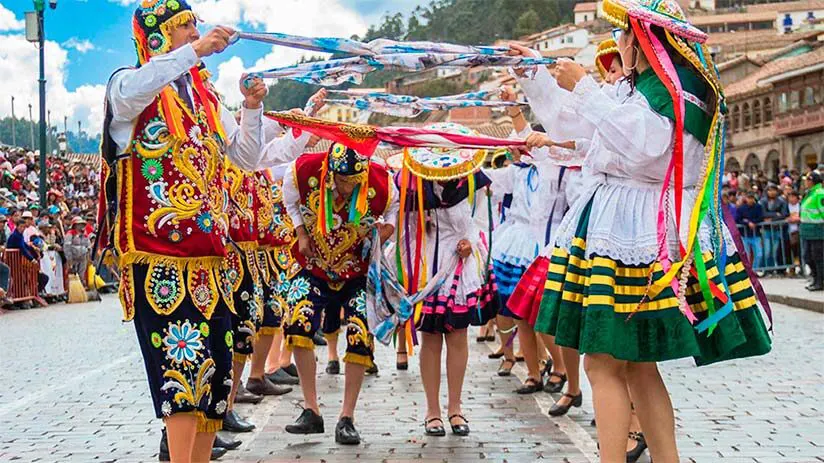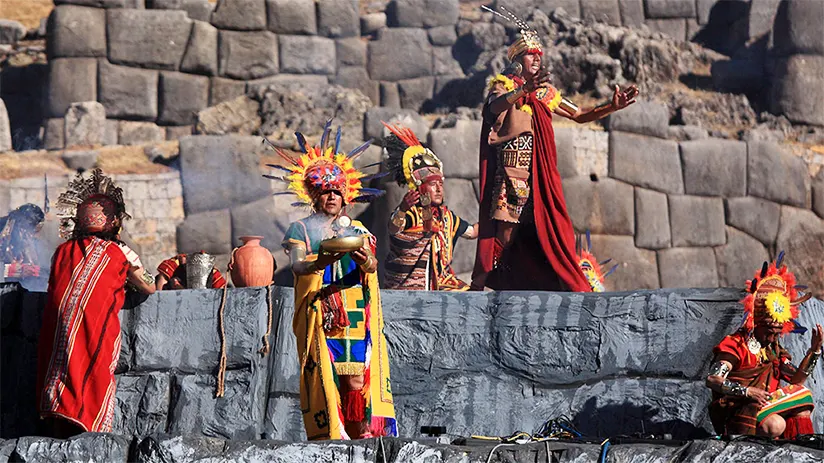Cusco, the most tourist city in Peru, can be visited at any time of the year. But to make the most of your stay, during May and June, you will be able to witness the cultural greatness of the city.
With a rich history and many traditional customs, it is no surprise that there are many celebrations and festivals. In general, the main celebrations have a strong religious theme. However, other festivities have traditional ancestral themes, dances, and rituals.
We worked with travel experts at Machu Travel Peru to create an article about the leading festivals in Cusco. This way, you will learn when and how every festival is held.
The months where the best festivals in Cusco take part
January

People celebrate the unique festival of Bajada de Reyes this month in Cusco. It highlights the area’s traditions and religious customs. This event happens every January 6th. It remembers when the three kings, Melchior, Gaspar, and Baltazar, traveled to Bethlehem. A star guided them. They came to honor Jesus, offer gifts, and share the good news about the future king.
This feast has three main parts. First, the Magi are staged. Next, there is a traditional procession through the streets of Cusco. Finally, the event includes a mass at the pescebre. All are accompanied by folkloric dances and typical costumes reflecting cultural and historical identity.
You can find a manger in the main square of Cusco where a religious ceremony is held. This act includes prayers, songs, and the adoration of Baby Jesus. It is also a moment of the community’s relationship and spiritual connection with the believers. Finally, a feast is offered for all food lovers during the descent of the kings. Traditional dishes, meninges, and drinks are available in the markets and street stalls.
February

In February, the well-known “Carnavales Cusqueños” happens. This festival brings together the people of Cusco. They celebrate the “Yunza or cortamontes” and enjoy water games. People decorate a tree with gifts and ribbons and then bring it down through dances and songs with an axe.
The first comprises the celebrations of compadres and comadres that occur on the two Thursdays before the central day of the carnivals. Here, it is characterized by the women visiting and entertaining their compadres and making fun of them by hanging rag dolls. In the same way, the compadres entertain the compadres, preparing dolls in the form of mockery but on the following Thursday.
The main celebration occurs on Sunday in the Plaza de Armas of Cusco. It starts early in the morning. People enjoy playing with water and moisture. A week later, the Kacharpari takes place. This event features dances and traditional foods. One popular dish is tempo. Timpu is a Cusco dish with boiled meat, moray, chickpeas, and potatoes.
According to several historians, the Spaniards brought carnivals to Cusco. The Andeans were attached to the Andean culture, so they made offerings to the Pachamama so that the harvest would be generous. February is the rainiest month in Cusco, coinciding with the rainy season and the ripening of crops related to the fertility of the land.
March/April

People celebrate Holy Week, or Semana Santa, in March and April. This is one of South America’s most celebrated religious weeks and a recognized festival in Cusco.
Holy Week is the last week of Lent until Easter Sunday. You can see marching bands, fireworks, and endless parties throughout the week. Religious or not, the festivities that take part in the week are a spectacle you won’t want to miss. Make sure to participate in the processions that usually go through some of Cusco’s top attractions.
In Cusco, the festival of the Lord of the Earthquakes is significant. This sacred image is the city’s patron. It goes out in procession every Holy Monday and welcomes approximately 70 to 80 thousand faithful devotees. In 2007, officials proclaimed the Señor de los Temblores feast as the Cultural Heritage of Peru.
May

The city of Cusco holds some festivals during May. Cruz Velacuy is one of the festivals you cannot miss. People celebrate this festival every May 3, considering it the beginning of all celebrations in Cusco. It started in the 18th century. Before, it was a small family celebration. People would offer gifts to the different “Crosses” in the city.
The festival begins with a traditional evening of the cross, during which a manager prepares the arrangements. The manager’s name is Carguyoq. This person offers an altar built in honor of the cross.

People celebrate the traditional and recognized Corpus Christi festival in May or June. People around the world know about this religious celebration. Cusco has a unique, colorful, and traditional history that started with the conquest of America.
When the Spanish noticed that the Incas held a parade where they took their mummies, they decided to end this tradition. To impose the Catholic religion, people exchanged mummies for images of Catholics and saints. This festival in Cusco imposed religion in this way. From that moment, the different old churches in Cusco have prepared colorful saints in beautiful dresses. During the three days this festival lasts in Cusco, you can enjoy many traditional dances. Taking part in Corpus Christi is one of the best things to do in Cusco. It is a unique moment where families gather and embrace cultural syncretism.
One of the most delicious dishes to taste in Corpus Christi is Chiriuchu, a “plate of cold food served”. People eat this traditional and typical dish cold with many ingredients. Chicken, guinea pig, chorizo, corn, hot peppers, cheese, dried meat, Cochayuyu, and more can be found.
The origin of this dish dates back to Inca times when different people came to the city to celebrate Corpus Christi. The other families brought ingredients from their homes, mixed them all on a plate, and created it. Tradition says that to enjoy this dish, you have to eat a little of everything at once. Today, you can enjoy this delicious dish at one of the best festivals in Cusco.
June

During June, organizers hold numerous parades to celebrate the Day of Cusco. Many public and private institutions, such as schools, universities, hotels, and tourism agencies, prepare pieces of typical dances.
The different parades in the Plaza de Armas present these dances during the days before the Day of Cusco. The school parades are contests where boys and girls in the last grade of primary and secondary school give their best. Universities and Institutes do the same but on established days. It is worth enjoying these shows in the city of Cusco.
The Escuela Superior de Arte de Bellas Artes parade showcases art and creativity in the Cusco main square. Here, creativity and art are part of a particular form of expression. The parade is full of color and music and will make you dance and enjoy yourself while you watch it.

Fireworks and a great night of music in the Plaza de Armas is a celebration in honor of the Inca city of Cusco. The organizers invite the whole town to a night of light, sound, and music in the main square, where attendees can enjoy varied music from different groups and a fireworks show that will illuminate the Cusco sky.
June 24th is Cusco’s anniversary, and the winter solstice is in this region. It is also a big celebration of the Festival of the Sun, known worldwide as the Inti Raymi Festival in the Quechua language.
Many people consider this the most critical celebration in honor of the main god of the Incas: the Sun. The Inti Raymi is a famous festival in Cusco, making June a great time to visit the Imperial City. Likewise, throughout June, the population revalorizes the ancient Inca and Spanish heritage.
July

We can find the Festival of the Virgen del Carmen during this month. She is the patron saint of Paucartambo in Cusco. The celebration brings together many people each year from July 15 to 18. You can see different dance groups, a religious procession, and the lively crowd of faithful celebrating their day with the Virgin in this town.
Likewise, we have a Independence Day that is one of Peru’s most important days in July. People celebrate Independence Day on July 28, and it serves as a national holiday.
Peru became independent in 1821, and you can see numerous celebrations throughout the country. Whether in Cusco or Lima, you can appreciate parades, parties, important events, exhibitions, and more. Cusco is a safe place in Peru. Don’t worry about your security.
August

Pachamama Day, Mother Earth’s Day, is celebrated on the first of August. This is one of the most traditional and ancient native celebrations of Cusco. Households typically pay homage to the land with offerings of food, drink, and any other personal items of value. People refer to this as payment to the land, where the Andean New Year begins.
September

In September, we celebrate the Feast of the Virgin of Nativity in Cusco. This event features a special version of the Virgin of Santa Maria. The days of celebration are September 7 to 9. However, August 29 is the traditional entrance, called “Tipa Apakuy”. People celebrate the entrance to the Nativity scene and the holidays with Eucharists, masses, and dances.
October

The entire month of October is dedicated to showing the majesty of the Imperial City and the surrounding region. In October, organizers schedule numerous events that exhibit different accessible and sale prices. This is much more evident during the Cusco Tourist Week. Many people take part in the city tour in Cusco and enjoy the many tours around it.
November

In November, Cusco celebrates the Day of All Saints and the Dead, a tradition with deep roots in the Cusco community. According to tradition, people believe that those who have died return to their homes on November 2nd.
Relatives create altars for their loved ones who have passed away. They decorate these altars with photographs, food, drinks, and cherished items to connect with the deceased. Likewise, villagers visit the main cemeteries to visit their graves and crypts. People now bring and share flowers, songs, dances, and prayers. This allows the celebration of death as part of life.
Similarly, people eat and sell T’anta Wawa in the most important markets. They serve sugared rolls to children in the shape of babies. According to the belief, they represent and facilitate the loved ones’ continuing their journey to tranquility.
December

December is a month where the festivities in Cusco manifest themselves in all their splendor. Christmas in Cusco is one of the best celebrations. People celebrate Christmas Eve with lively parties and festivities until late at night. At the same time, Christmas Day is usually a much more family day. You can find the famous Andean nativity scenes in strategic places in Cusco, such as Coricancha and Plaza Mayor de Armas or San Francisco etc.
“IN THE GARDEN OF YOUR DAYS CULTIVATE FESTIVITY, PLAY, AND CELEBRATIONS”.
Cusco is a city where festivities abound. Every month of the year, you can appreciate one or another holiday. Together with the experts of Machu Travel Peru, we try to gather those unmissable months to celebrate. If you want to know more about our tours of the city, you can consult with our advisors.
Peru has so much to offer, it can be hard to know where to start. With many years of experience in the tourism sector, Machu Travel Peru is happy to help with anything regarding your trip to Machu Picchu and any tours around it. Make your Machu Picchu experience an unforgettable one!
